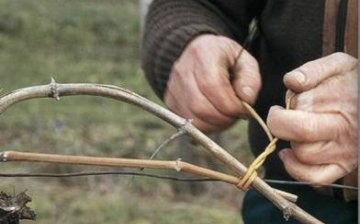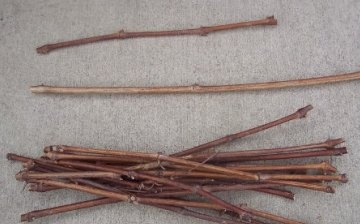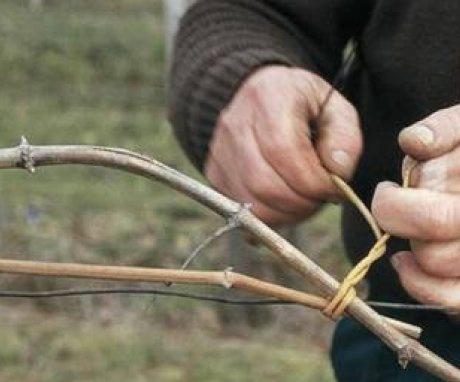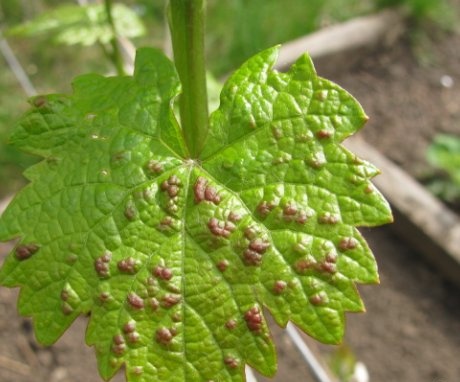Valentine grapes: reproduction and proper care
Grape Valentine belongs to the table varieties. In terms of care, Valentine's grapes are not much different from their counterparts. Therefore, it does not require special attention to itself, all the necessary procedures are carried out in parallel with other vine plantations.
Content:
- Description of the grape variety Valentine
- Valentine grape care
- Propagation of grapes Valentine
- Diseases and pests
Description of the grape variety Valentine
Bushes varieties grapes Valentines have strong vines, thrive well and bloom profusely in spring. Bisexual flowers facilitate pollination. The bunches are large and long, in a fruitful and sunny year, one bunch can reach 40 cm in length. The big advantage of this variety is that the berries ripen evenly along the entire length. The bunches are loose, loose, but can weigh up to 1.5 kg.
The maturation period of the Valentine variety lasts 4.5 months.
The berries are large enough and have an oblong-oval shape. They are colored greenish-yellow with brownish dots, translucent in the sun. The skin is thin and hardly noticeable when eaten. The pulp is tender, juicy, sweet with a gentle note of nutmeg when ripe. There are few seeds, in one berry there are no more than 2 pieces.
Valentine grape care
The Valentina variety tolerates cold temperatures well down to -22 degrees. If the thermometer drops below, then the vines and buds may freeze and the harvest of the season will be low. Therefore, for the winter period in cold regions, it is recommended to insulate and add grapes. In the spring, the process is reversed.
When the ground has already begun to warm up, you can open the vines and tie them to the supports.
Recommendations for the care of the grape bush:
- Everyone bush you need to carefully examine for the presence pests or diseases and, if necessary, treat with the appropriate drug or delete. It is worth noting that after a burrowed wintering, a white bloom can form on the vines, after a few days it should disappear.
- It is necessary to dig a small depression around the bush, you can also mulch it to retain more moisture. To water during this period it is not recommended, since the moisture absorbed during the winter has not yet dried out, and with an excess of it, the root system can rot.
- Valentines grapes require watering only in the spring and during berry pouring. When ripe, the bush does not need additional moisture. Watering or heavy rain can cause the berries to burst and deteriorate transportability and shelf life.
- In the autumn, the grape bushes are prepared for winter. For this, excess branches are cut, weak and diseased vines are removed. The bush is abundantly watered and mulched. Before the onset of severe frosts, the vines are wrapped in paper, bent to the ground, fixed and sprinkled with earth.
Propagation of grapes Valentine
Valentine's grapes are propagated, like most varieties, with the help of cuttings... There are also other methods, but all gardeners and summer residents use this method.
- Cuttings cut in the autumn, when the bush is being prepared for wintering.
- A strong and ripe vine is selected, which has not yet begun to grow stiff.
- One cutting should contain 2-3 healthy, strong buds.
- When the material is prepared, it is collected, wrapped in a damp cloth and placed in a cool place. A basement or a vegetable drawer in the refrigerator works well for this.
- The cuttings should not dry out, so they should be checked periodically and the cloth should be dampened.
- In late December, early January, cuttings are removed from storage.
- Each branch must be inspected and dried.
- After, all the cuttings are placed in a container with a manganese solution for disinfection.
- After 10–12 hours, they must be removed, rinsed and placed in another container with clean water at room temperature, where they will remain for 24–48 hours.
- After that, each stalk must be checked for suitability. For this, the lower part is cut off by 0.5-1 cm, if the cut is pale green, such a stalk is ready for rooting.
- If there are dry areas or rot on the cut, you cannot work with such a cuttings.
- For rooting, the lower part of the cutting is cut to the lower bud at an oblique angle, and the upper part of the bud is carefully removed.
- The reverse part of the knife blade makes shallow scratches in the lower part of the cutting for root germination.
- The finished material must be placed in a solution that stimulates root growth for 15-20 hours.
- Further, the lower prepared part of the cuttings is wrapped in a damp cloth and polyethylene, so that the moisture lingers longer.
- They are laid out on the windowsill so that the roots are on the side of the battery, and the tops are looking at the window.
- The fabric should be checked periodically for moisture. It is recommended to treat the upper cut with paraffin so that moisture does not evaporate intensively through it.
After a while, the buds will turn green, and a little later the leaves will appear, this is a signal to check the roots and plant a young shoot in a prepared container with a substrate for further development seedlings.
Diseases and pests
Grapes are often exposed to various fungal diseases and attacks. pests... There are many drugs, including bio, for the treatment and processing.
To prevent diseases, the bushes are treated several times in the spring and summer.
Such actions also help against certain insect pests. Nevertheless, it is recommended to constantly examine the plants for the presence of ailments and, at the first manifestation, take up treatment.
Valentine grapes are used both raw and in making wine or grape juice at home.
More information can be found in the video.
















